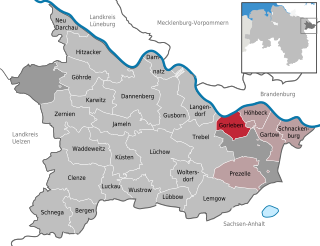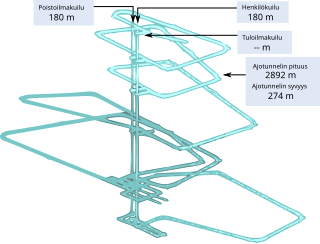
Radioactive waste is a type of hazardous waste that contains radioactive material. Radioactive waste is a result of many activities, including nuclear medicine, nuclear research, nuclear power generation, nuclear decommissioning, rare-earth mining, and nuclear weapons reprocessing. The storage and disposal of radioactive waste is regulated by government agencies in order to protect human health and the environment.

The Yucca Mountain Nuclear Waste Repository, as designated by the Nuclear Waste Policy Act amendments of 1987, is a proposed deep geological repository storage facility within Yucca Mountain for spent nuclear fuel and other high-level radioactive waste in the United States. The site is on federal land adjacent to the Nevada Test Site in Nye County, Nevada, about 80 mi (130 km) northwest of the Las Vegas Valley.

Dry cask storage is a method of storing high-level radioactive waste, such as spent nuclear fuel that has already been cooled in a spent fuel pool for at least one year and often as much as ten years. Casks are typically steel cylinders that are either welded or bolted closed. The fuel rods inside are surrounded by inert gas. Ideally, the steel cylinder provides leak-tight containment of the spent fuel. Each cylinder is surrounded by additional steel, concrete, or other material to provide radiation shielding to workers and members of the public.

KBS-3 is a technology for disposal of high-level radioactive waste developed in Sweden by Svensk Kärnbränslehantering AB (SKB) by appointment from Statens Strålskyddsinstitut. The technology was developed by studying different natural storage facilities such as the natural reactor in Oklo, Gabon and the uranium mine in Cigar Lake, Saskatchewan, Canada. The general theory is that radioactive rock in these sites has been present for thousands of years, and has not affected the health and well-being of human populations. KBS-3 is also to be used in Finland at the Onkalo spent nuclear fuel repository, being built by Posiva.

Ignace is a township in the Kenora District of Northwestern Ontario, Canada, located at Highway 17 and Secondary Highway 599, and on the Canadian Pacific Railway between Thunder Bay and Dryden, Ontario. It is on the shore of Agimak Lake, and as of 2016, the population of Ignace was 1,202.
The Whiteshell Laboratories, originally known as the Whiteshell Nuclear Research Establishment (WNRE) was an Atomic Energy of Canada (AECL) laboratory in Manitoba, northeast of Winnipeg. It was originally built as a home for the experimental WR-1 reactor, but over time came to host a variety of experimental systems, including a SLOWPOKE reactor and the Underground Research Laboratory to study nuclear waste disposal. Employment peaked in the early 1970s at about 1,300, but during the 1980s the experiments began to wind down, and in 2003 the decision was made to close the site. As of 2017 the site is undergoing decommissioning with a planned completion date in 2024. The decommissioning process for WR-1 involves transporting low-level nuclear waste to another Canadian Nuclear Laboratories (CNL) research site, Chalk River Laboratories in Ottawa for containment, and encasing the reactor in concrete. The details of this process continue to be criticized, evaluated, and revised.

The Nuclear Waste Policy Act of 1982 is a United States federal law which established a comprehensive national program for the safe, permanent disposal of highly radioactive wastes.
Nuclear power in Canada is provided by 19 commercial reactors with a net capacity of 13.5 gigawatt (GW), producing a total of 95.6 terawatt-hours (TWh) of electricity, which accounted for 16.6% of the country's total electric energy generation in 2015. All but one of these reactors are located in Ontario, where they produced 61% of the province's electricity in 2019. Seven smaller reactors are used for research and to produce radiopharmaceuticals for use in nuclear medicine.

A deep geological repository is a way of storing hazardous or radioactive waste within a stable geologic environment, typically 200–1,000 m below the surface of the earth. It entails a combination of waste form, waste package, engineered seals and geology that is suited to provide a high level of long-term isolation and containment without future maintenance. This is intended to prevent radioactive dangers. A number of mercury, cyanide and arsenic waste repositories are operating worldwide including Canada and Germany. Radioactive waste storage sites are under construction with the Onkalo in Finland being the most advanced.

Gorleben is a small municipality (Gemeinde) in the Gartow region of the Lüchow-Dannenberg district in the far north-east of Lower Saxony, Germany, a region also known as the Wendland.

South Bruce is a municipality in Bruce County, Ontario, Canada.
Nuclear entombment is a method of nuclear decommissioning in which radioactive contaminants are encased in a structurally long-lived material, such as concrete. This prevents radioactive material and other contaminated substances from being exposed to human activity and the environment. Entombment is usually applied to nuclear reactors, but also some nuclear test sites. Nuclear entombment is the least used of three methods for decommissioning nuclear power plants, the others being dismantling and deferred dismantling. The use of nuclear entombment is more practical for larger nuclear power plants that are in need of both long and short term burials, as well as for power plants which seek to terminate their facility licenses. Entombment is used on a case-by-case basis because of its major commitment with years of surveillance and complexity until the radioactivity is no longer a major concern, permitting decommissioning and ultimate unrestricted release of the property. Considerations such as financial backing and the availability of technical know-how are also major factors.

Ontario Power Generation Inc. (OPG) is a Crown corporation and "government business enterprise" that is responsible for approximately half of the electricity generation in the province of Ontario, Canada. It is wholly owned by the government of Ontario. Sources of electricity include nuclear, hydroelectric, wind, gas and biomass. Although Ontario has an open electricity market, the provincial government, as OPG's sole shareholder, regulates the price the company receives for its electricity to be less than the market average, in an attempt to stabilize prices. Since 1 April 2008, the company's rates have been regulated by the Ontario Energy Board.

High-level radioactive waste management addresses the handling of radioactive materials generated from nuclear power production and nuclear weapons manufacture. Radioactive waste contains both short-lived and long-lived radionuclides, as well as non-radioactive nuclides. In 2002, the United States stored approximately 47,000 tonnes of high-level radioactive waste.
The Deep Geologic Repository Project (DGR) was a proposal by Ontario Power Generation (OPG) in 2002 for the site preparation, construction, operation, decommissioning and abandonment of a deep geological radioactive waste disposal facility for low and intermediate-level radioactive waste (L&ILW). In 2005, the municipality of Kincardine, Ontario volunteered to host the facility located on the Bruce nuclear generating station adjacent to OPG's Western Waste Management Facility (WWMF). The facility would have managed L&ILW produced from the continued operation of OPG-owned nuclear generating stations at the Bruce, Pickering Nuclear Generating Station and Darlington Nuclear Generating Station in Ontario. In May 2020, after 15 years of environmental assessment, OPG withdrew its application for a construction license on Saugeen Ojibway Nation Territory.

Nuclear industry in Canada is an active business and research sector, producing about 15% of its electricity in nuclear power plants of domestic design. Canada is the world's largest exporter of uranium, and has the world's second largest proven reserves. Canada also exports nuclear technology within the terms of the Nuclear Non-proliferation Treaty, to which it is a signatory, and is the world's largest producer of radioactive medical isotopes.

The Schikorr reaction formally describes the conversion of the iron(II) hydroxide (Fe(OH)2) into iron(II,III) oxide (Fe3O4). This transformation reaction was first studied by Gerhard Schikorr. The global reaction follows:

The Onkalo spent nuclear fuel repository is a deep geological repository for the final disposal of spent nuclear fuel. It is near the Olkiluoto Nuclear Power Plant in the municipality of Eurajoki, on the west coast of Finland. It will be the world's first long-term disposal facility for spent nuclear fuel. It is being constructed by Posiva, and is based on the KBS-3 method of nuclear waste burial developed in Sweden by Svensk Kärnbränslehantering AB (SKB). The facility will be operational by 2026, and decommissioned by 2100.

A Blue Ribbon Commission on America's Nuclear Future was appointed by President Obama to look into future options for existing and future nuclear waste, following the ending of work on the incomplete Yucca Mountain Repository. At present, there are 70 nuclear power plant sites where 65,000 tons of spent fuel is stored in the USA. Each year, more than 2,000 tons are added to this total. Nine states have "explicit moratoria on new nuclear power until a storage solution emerges". A deep geological repository seems to be the favored approach to storing nuclear waste.
The Underground Research Laboratory was a test site for deep geological repository of nuclear waste operated by Atomic Energy of Canada Limited's (AECL's) Whiteshell Laboratories near Lac du Bonnet in Manitoba, Canada. The site was built inside a large granite batholith, typical of the Canadian Shield. The site was selected in 1980, construction began in 1982 and it opened in 1985. No radioactive material was stored at the site, it was used purely for measurements of water exchange, rock movement, and other issues that would affect the safety of such materials. The site was also used by a variety of international users. As part of the wider wind-down of AECL activities, the decision was made to close the URL in 2003. Cleanup work began in 2006 and completed in 2010. The site continues to host a single international experiment measuring water leakage through a massive clay plug.














